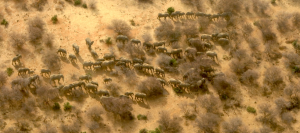Thinking Big: The Secret of Survival among Mali’s Desert Elephants

PHOTO CREDIT: © CHYULU SMITH
Press Release
Satellite tracking of elephants living near Timbuktu has revealed the secret of their survival in the savage conditions of Mali’s desert.
The elephants of Africa’s northernmost population use over 32,000 square kilometres of the Gourma region in their epic quest for food and water, the largest range ever recorded for the species.
Their circular migration route is also thought to be unique to this population. The findings, published this week in the journal Biological Conservation, have profound implications for efforts to ensure the continued existence of these elephants.
“It’s incredible these elephants have survived. They have a truly stressful life with the lack of water and food, and their giant range reflects that,” said Jake Wall of Save the Elephants, Kenya (also of the University of British Columbia, Vancouver), who led the study.
Global Positioning System (GPS) collars were attached to nine elephants in March 2008. Over the next two years they were tracked moving in a large circular arc that extended into northern Burkina-Faso. Twice they had to cross a major highway.
The Gourma elephants are a desert-adapted species of African elephants (Loxodonta africana) and frequently endure sand storms, water shortage, and temperatures over 50 degrees Celsius (122 Farenheit),. A severe drought in 2009 dried out Lake Banzena completely, depriving the elephants of one of their key watering points.
The tracking collars show that the Gourma elephants have an annual journey that encompasses an area of over 32,000 square kilometres, the largest known elephant range anywhere in the world. Although they walk similar distances to their East and Southern African relatives, their movements are spread out over an area 150 per cent larger than those reported in Namibia, and 29 per cent larger than elephants in Botswana.
“Although the Gourma elephants are currently free to move over a wide range, we found they spend a large amount of time in relatively few areas – called ‘hot-spots’ – that we believe are critical for their survival. These elephant hot-spots should be considered conservation priorities,” said Wall.
The data also revealed the network of pathways that the elephants use. A mile-wide gateway in a sandstone ridge known locally as ‘la Porte des Elephants’ is revealed as a critical bottleneck. Currently there is little human settlement in the area but if that changes the elephants may become isolated from key parts of their range, said Mr Wall.
The Gourma elephants have historically enjoyed relatively peaceful coexistence with the local Toureg, Fuhlani and Dogon peoples. Until recently these groups mainly practiced pastoralism but are now beginning to settle and turning to agriculture. Conflict between humans and elephants is increasing as a result.
The trigger for their immediate movement to their southern range is the start of the rainy season in April-May, but it is speculated that the timing of their north-south movement is the result of differing vegetation and plant protein levels as opposed to direct access to surface water.
On surprise finding was that male and female elephants in Gourma used such different ways to find food and water that they shared only a quarter of their ranges.
“We think the difference is partly because of their tolerances towards people. Bulls generally take more risks and occupy areas that have higher human densities,” said Mr Wall. “They also have varying food strategies and we think that differences in the areas they occupy might be because of different vegetation types in those areas.”
The Gourma elephants are believed to be the most northerly population of elephants in Africa since the loss of the Atlas mountains population in the 1970’s, and are remnants of a much larger population that once extended across the entire north of Africa. Hunting by man and climatic changes have reduced their numbers and range considerably. Today there are estimated to be around 350 remaining individuals.
Until recently the ivory poaching crisis that is currently ravaging elephant populations across Africa had not impacted Gourma. This year at least three elephants have been killed in the region. With little protection for elephants in the area, their own tusks may yet prove a greater threat than the extreme conditions in which they have learnt to survive.
Profits from the illegal ivory trade are known to fuel terrorist groups like the Lord’s Resistance Army, the Janjaweed and Al Shabaab. Organized crime syndicates are linking up with them to move the ivory around the world, exploiting turbulent states, porous borders and corrupt officials from sub-Saharan Africa to China, law enforcement officials say.
“The Mali elephants with their record breaking migration have maintained their numbers in extreme natural conditions of heat and drought. We now fear that they may become victims of civil disturbance in the North of Mali due to the uprising currently taking place,” said Iain Douglas-Hamilton of the Institute of Zoology at the University of Oxford and Founder of Save The Elephants.
Dr Douglas-Hamilton added that a new anti-poaching initiative by the WILD foundation and the International Conservation Fund of Canada was beginning to engage local communities and national foresters in defence of elephants. The success of the scheme is all that stands between the poachers and their prey.
Save The Elephants has worked in partnership with The WILD Foundation (http://www.wild.org) for over 10 years providing critical field research on the Gourma elephant migration. Based on this information The WILD Foundation began working with local communities to protect the elephants while also meeting their own needs for clean water and good grazing. The WILD Foundation, now with the International Conservation Fund of Canada, has developed this model very successfully, extending it across the elephant range, working at all levels of government and engaging the local people.
Photos of the Gourma elephants from the National Geographic television series Great Migrations

